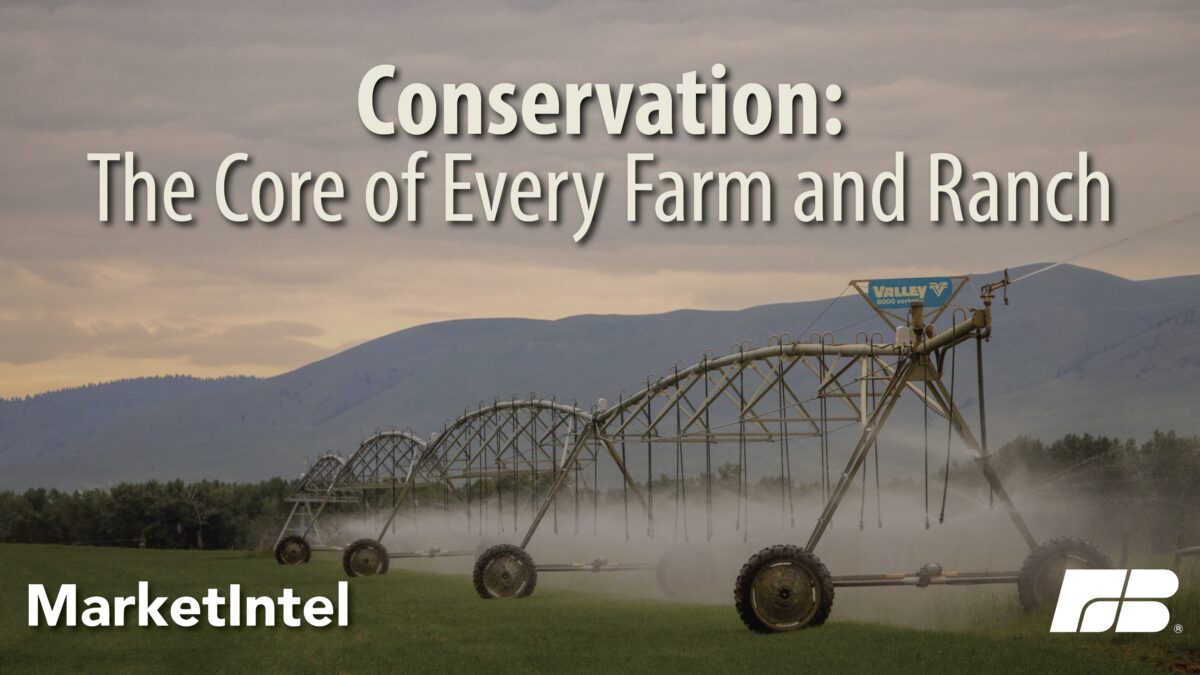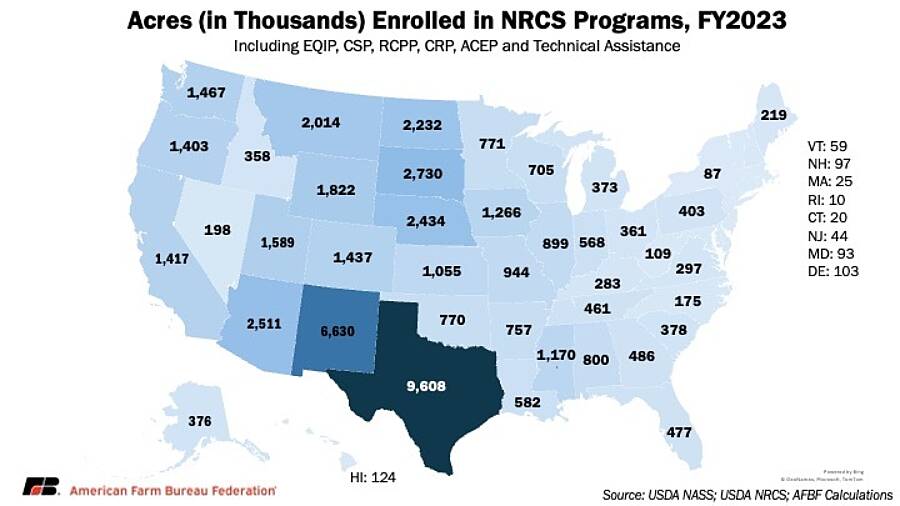It’s Just What They Do: Farmers and Ranchers Care for the Land

Samantha Ayoub
Associate Economist
The word “conservation” isn’t as catchy as buzzwords and phrases like “sustainability,” “regenerative” or “climate smart”, but they’re all at the root of farmers’ and ranchers’ core value of being good stewards of the land they rely on to support their operations today and for future generations.
Healthy Land
Farmers’ number one asset is land. Whether they’re growing crops or raising livestock – or both, farmers use practices that maintain or improve the high quality of their land. Conserving land includes protecting soil health, retaining water and attracting pollinators, all of which benefits the farm and the environment.
Healthy soil, essential to growing crops and to providing forage for livestock, was the foundation of conservation efforts by the United States government starting in 1929, prompted by the Dust Bowl. USDA stepped into conservation services on a large scale beginning in 1935 when the Soil Conservation Act created the Soil Conservation Service, what eventually became the modern Natural Resources Conservation Service (NRCS). Now, NRCS promotes stewardship of all resources – water, soil, air and biodiversity. They allocate over $3.7 billion a year in financial assistance for farmers and ranchers and provide additional technical consultation to help install conservation practices on more than 53 million acres nationwide each year – an area the size of Idaho.
There are over 100 individual practices eligible for NRCS assistance, tailored to the management needs of the diverse resources and agricultural production across the country. The top practices funded each year range from cover cropping and reduced tillage that promote soil health to sprinkler systems that better manage scarce water use to planting trees and shrubs that provide wind breaks for homes and livestock while also slowing wind erosion. Farms and ranches may also fulfill their NRCS contracts and continue utilizing conservation methods or implement conservation practices without initial support. For example, more than 200 million acres nationwide are operated using reduced or no tillage.
Targeted programs may be developed in some states to meet specific resource needs or USDA priority areas. The Environmental Quality Incentives Program (EQIP) also incentivizes continued agricultural innovation from businesses or farmers and ranchers themselves through Conservation Innovation Grants.
Farm and ranch conservation practices are widespread, and many are norms in farm production. Around 90%of major row crops are grown in some sort of rotation. Rotating crops maintains nutrient balance in soil and discourages weed growth. Managed grazing maintains soil cover to prevent erosion, increases soil organic matter and improves soil structure to help retain water, reducing drought impacts. Nutrient managementfocuses on applying agricultural chemicals like fertilizer, manure or pesticides at the correct volume and effective time to prevent runoff of excess nutrients and maintain soil nutrient balance. These traditional conservation practices all also have important economic benefits, which promotes their widespread adoption.
Healthy Farms
Conservation practices come with economic tradeoffs, but many have benefits. In the short term, some practices reduce the inputs needed for farming. No-till reduces the number of tractor passes over a field, reducing equipment wear, lowering fuel needs and saving farmers’ time; however, if used in combination with cover cropping, not tilling would increase the need for herbicides. Nutrient management plans can reduce production costs by limiting chemical inputs, but they need additional investments in soil testing to create and monitor the plan. Crop rotation reduces the need for some chemical inputs by balancing soil nutrients and limiting pests. It can also help farmers spread their risk by diversifying since they are not reliant on market changes of only one crop.
Over time, traditional conservation improves traits like soil organic matter, ground water recharge or increased biodiversity that help the natural environment better sustain crops and forage without constant management. In the long term, all these practices make the environment even better, which is why environmental conservation is often called “regenerative,” and retaining and restoring soil are key to a farm’s economic health for today and for future generations.
Healthy Communities
Runoff is the equivalent of money running right off your fields. Preventing runoff of soil, water and inputs not only protects farmland, but also benefits the community. As farmers and ranchers raise their families and live on their farms and in their rural communities, it is also in their interest to protect the resources of the area.
Some NRCS programs focus on bringing together farmers and ranchers, local governments and the greater community to target the health of entire areas. Watershed programs improve water quality and availability and reduce flood damage to farms and rural communities. The Mississippi River Basin Healthy Watershed Initiative(MRBI) has implemented conservation on 1.5 million acres, reducing sediment loss by over 2.4 million tons and phosphorous and nitrogen runoff by over 25 million pounds combined. The Regional Conservation Partnership Program leverages collaboration between local entities and the federal government to target resource projects crucial to specific areas. Both individual farm conservation methods and community-wide initiatives have critical benefits to maintaining farmland health and ensuring communities nationwide have clean, sufficient water and land.
Other Benefits
As science progresses, new benefits are linked to agricultural conservation. Most recently, incentives were made to practices that promote carbon sequestration, a naturally occurring process in plants. Many of the conservation practices that improve soil health also improve the ability of plants to hold carbon in the soil simply because the land is better equipped to hold and retain nutrients.
In 2022, the Inflation Reduction Act (IRA) dedicated $18 billion to NRCS conservation programs that “directly improve soil carbon, reduce nitrogen losses, or reduce, capture, avoid, or sequester carbon dioxide, methane, or nitrous oxide emissions, associated with agricultural production.” Programs under the new funding were dubbed “climate smart” since reduction and sequestration of these gases were expected to combat agricultural contributions to global emissions and climate change. These practices are largely the same traditional conservation practices farmers have been using for decades – the climate benefits were just being highlighted. In fact, more than half of the practices funded by standard farm bill conservation programs also received IRA funding.
Conclusion
Operating on an outdated farm bill limits farmers’ and ranchers’ ability to invest in traditional practices since inflation has reduced the value of conservation funding dollars in the 2018 farm bill. Some conservation programs lost all of their funding in the last extension of the farm bill. IRA funds were one way to support the work farmers and ranchers do to protect their land for themselves, their communities and future generations.
Yet, conservation funding has gotten tangled in conservation buzzwords, leaving farmers and ranchers trying to take care of their land in the middle of the knot. More than $1.7 billion from IRA funds has been obligated through fiscal year 2024 for contracts spanning 11.8 million acres; EQIP funding in fiscal year 2024 was almost equally split between farm bill and IRA funding. These programs both aim to help farmers and ranchers serve as good stewards of their resources, and the work they do in each is almost identical.
Overall, conservation is at the heart of farming and ranching. To continue to operate, farmers and ranchers are reliant on land, water and nutrients that are healthy and stable, and it is in their best interest to take steps to protect them. Any other benefits we find along the way – and the names society ties to them – are added bonuses to the work agriculture has been doing for generations.

